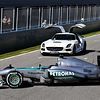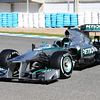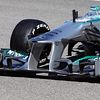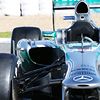Mercedes F1W04 launch - technical analysis
Mercedes have gone back to basics, shedding all the special items from its W03 and designing a better car with a basic layout. While this may be strange to some, it is really what Mercedes need in order to get its facts right from the beginning of the season.
The team has not had the best of seasons in recent years. In fact it has showed promise with all its previous cars, but none have managed to fulfill the expectations there were there before the season. Each time, the car failed to work consistently while all cars ate away Pirelli rubber as if it was lunch.
This time around, Mercedes seem to have focused on the things that matter. First trying to get a good aerodynamic basis with a coanda style exhaust that has been tested all through the winter in the windtunnel, and secondly doing slight modifications to the suspension in order to keep the good properties while attempting to iron out the notorious hardness on the tyres.

First of all, the front wing on the new W04 is identical to the specification that was run at the Brazilian GP of 2012. Team principal Ross Brawn however said at the launch "the aerodynamic design philosophy has been optimised around a new five-element front wing design and a second-generation Coanda exhaust at the rear". We may therefore expect a new version of that wing pretty soon.
While the front wing pillars have also remained identical (at the moment), the nose is obviously similar, but different as it has a small vanity panel on the top, giving a small aerodynamic advantage, apart from the obvious aesthetic improvement.
In the cockpit area it is most obvious that the mirrors have changed position, now being higher and closer inboard compared to the W03. The most important change however seems to be the modified airbox, where the main air inlet has been given a more oval shape. The secondary inlet behind the roll hoop has gone, indicating that cooling for the gearbox now uses cooling air from the sidepods. The small KERS cooling unlet underneath the airbox remains but is now almost perfectly circular instead of the wide gap it was before.
The F1W04 also features 3 fins underneath the mirrors, similar to what Ferrari introduced late in the season on their Ferrari F2012.
The sidepods have also been extensively reshaped, with the inlets being a little further up from the ground, allowing more of the low flowing air to pass around the sidepod and flow onto the diffuser. As a side effect, this change also makes it less likely that debris on track ends up in the radiators.
The upper surface of the sidepods features a slight U-shape as the pods are higher on the outer edge. It is this higher outer edge that ends up in the bulge that houses the Coanda exhaust, effectively a development of the exhaust that Mercedes have tried several times during 2012. Back then, the team found out the system provided more downforce, but that it was heating the tyres, inducing even higher tyre wear. One may expect that the team have finally managed to resolve this issue after months of testing in the windtunnel.
Brawn also pointed out that the rear end of the car has been "aggressively repackaged" in order to allow more aerodynamic development at the rear. Since the banning of the double diffusers, the team has struggled to claw back its lost downforce at the back, and are hereby trying to pose a remedy to the illness.
A final note goes to the rear wing, which now has a traditional DRS actuator in the middle of the wing, ditching the previous system that was incorporated in the rear wing end plates. This used to be beneficial as the team also had its double DRS channel incorporated in the endplate, but since this is effectively banned, it is more efficient to have a single, central hydraulic actuator like all other teams.
All in all, Mercedes have opted to try to resolve the main problems of the F1 W03 and have reverted to a rather basic aerodynamic layout to have a proper baseline.







